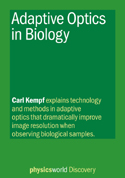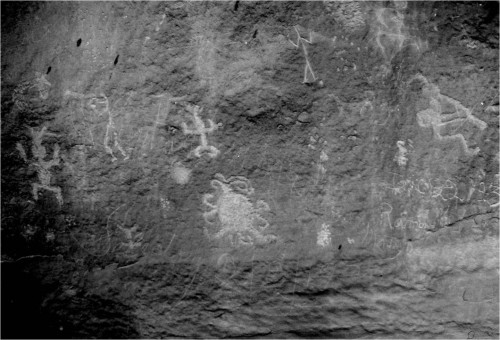Tag archives: astronomy
See in the new year with the January 2018 issue of Physics World
Happy new year and welcome back to Physics World after our winter break. Why not get 2018 off to a great start with the January 2018 issue of Physics World, which is now out in print and digital format.
In our fantastic cover feature this month, Imre Bartos from Columbia University in New York examines the massive impact on physics that last year’s spectacular observation of colliding neutron stars will have.
Elsewhere, Bruce Drinkwater from the University of Bristol explains how he is using ultrasonics to monitor the damaged Fukushima nuclear-power plant in Japan, while science writer Jon Cartwright looks at how technology can help blind physicists.
Don’t miss either our interview with Fermilab boss Nigel Lockyer and do check out our tips for how to brush up your CV if you’re chasing a job in industry.
View all posts by this author | View this author's profile
Adaptive optics in biology
By Matin Durrani
For centuries, astronomers looking up at the heavens through a telescope had a problem on their hands – the quality of their images depended on the strength and direction of the wind in the air. Trouble is, the Earth’s atmosphere isn’t uniform because its density – and thus its refractive index – varies from point to point as the wind blows. Result: distorted images.

Carl Kempf’s new short-form Physics World Discovery ebook is free to read
In 1953, however, astronomer Horace Babcock proposed a clever solution, which was to bounce incoming light off a device that can rapidly correct for changes in optical path-length, which flattens the wave-front and so counteracts the effects of aberration. Any remaining wave-front errors are measured after the correction, before a feedback control loop uses the measurement to continuously adjust the corrections applied to the wave-front.
That was the principle behind “adaptive-optics” technology, which has since gone on to become a routine and invaluable part of astronomy. Turns out, however, that the same principles can be used in microscopy too, leading to many applications of adaptive optics in medicine and biology too, as I’ve discovered by commissioning and editing a new short-form Physics World Discovery ebook by Carl Kempf.
Kempf is a senior systems engineer at the California-based firm Iris AO, Inc, which is heavily into adaptive-optics technology, having worked on sensing, actuation, and control systems for high-precision devices for more than 30 years. I’m pleased to say that Kempf’s short ebook, Adaptive Optics in Biology, is now available for you to read free in EPUB, Kindle and PDF format via this link.
To give you some more idea of what the book is about and his career to date, I put some questions to Kempf, which you can read below. Don’t forget either that there are plenty of other books in the Physics World Discovery series, ranging from multimessenger astronomy to quantitative finance.
View all posts by this author | View this author's profile
A decade of success

Looking forward: Hitoshi Murayama. (Courtesy: Kavli IPMU)
By Michael Banks in Tokyo, Japan
Just a couple of weeks ago the Kavli Institute for the Physics and Mathematics of the Universe (IPMU) marked its 10th anniversary.
Located on the University of Tokyo’s Kashiwa campus, the institute held a big celebration that was attended by hundreds of researchers including Nobel prize winners. The occasion was even marked by the creation of a bespoke sweet (see image below right).
View all posts by this author | View this author's profile
Prize-winning astronomy image, the ultimate cost of Cassini, amazing facts about lasers

Prize winning: the Rho Ophiuchi Cloud Complex captured by Artem Mironov (Courtesy: Artem Mironov)
By Hamish Johnston and Michael Banks
Hats off to the Russian photographer Artem Mironov, who has beaten thousands of amateur and professional photographers from around the world to win the 2017 Insight Astronomy Photographer of the Year. The award is in its ninth year and is run by the Royal Observatory Greenwich together with Insight Investment and BBC Sky at Night magazine. Mironox’s image, which was taken over three nights from a farm in Namibia, is of the swirling dust and gas clouds in the Rho Ophiuchi Cloud Complex. The object is situated approximately 400 light years away from Earth and is home to a cluster of more than 300 protostars. As well as winning the £10,000 top prize, Mironov’s image will be on display along with other selected pictures at an exhibition at the Royal Observatory that will run until 28 June 2018. The competition received over 3800 entries from over 90 countries. (more…)
View all posts by this author | View this author's profile
The sounds of Saturn, dancing particles, distracted funding agency
By Hamish Johnston
Astronomy can be a highly visual science and therefore developing ways of sharing data with visually impaired colleagues – and the public – is an important challenge. Sound offers one way forward, as astrophysicist Wanda Diaz Merced explains in “The sounds of science”. Now, fellow astrophysicists Matt Russo and Dan Tamayo at the University of Toronto have converted the motions of the rings and moons of Saturn into two musical compositions. You can listen to a composition based on the orbital frequencies of moons and rings by playing the video above. The second piece is called “Resonances of Janus translated into music”.
View all posts by this author | View this author's profile
The September 2017 issue of Physics World magazine is now out
 By Matin Durrani
By Matin Durrani
Some of the daily challenges facing women in physics are tackled in the latest issue of Physics World magazine, which is now out.
As well as a round-up from the recent International Conference on Women in Physics, which took place in Birmingham, UK, there’s a fascinating feature about the life of Jocelyn Bell Burnell. She discovered pulsars 50 years ago next month and became the first female president of the Institute of Physics, which publishes Physics World.
As Bell Burnell points out, “Fix the women!” is often seen as the solution to why women progress more slowly in physics than men. In fact, she argues, larger problems – notably institutional bias and poor policies – are to blame.
Don’t miss either our cover feature on the stunning images Cassini has been beaming back over the last few months before it plunges into Saturn on 15 September. We’ve also got a great Lateral Thoughts article by Daniel Whiteson, illustrated by PHD Comics artist Jorge Cham. Plus, find out how groups of cells move, communicate and organize themselves in networks.
Remember that if you’re a member of the Institute of Physics, you can read Physics World magazine every month via our digital apps for iOS, Android and Web browsers.
View all posts by this author | View this author's profile
Documentary explores the history of astronomy in China
By James Dacey
A new documentary explores the development of astronomy in China, taking viewers from the protoscience of ancient China through to the nation’s ambitious space exploration programmes of today. Directed by Beijing-based filmmaker René Seegers, the film has recently been broadcast on Shanghai Television along with screenings at a range of academic institutions, cultural and scholarly societies and embassies throughout China. Now, you can watch the film on the Physics World YouTube channel (with English subtitles).
“The Ancient Chinese believed that Heaven was a power, or a deity, which judged humans. Heaven was responsible for weather and for natural disasters. It was not a realm accessible to humans,” explains Ying Da, the documentary’s presenter. Ying is a media personality who shot to fame in China for directing the family sitcom I Love My Family (1993–1994).
Of course, in recent times Chinese scientists and engineers have taken a much more proactive approach to understanding the cosmos. Since the People’s Republic of China launched its first satellite in 1970 (Dong Fang Hong I), the nation has been ramping up its space programmes. The documentary takes viewers to observatories and the final construction phase of the Five-hundred-meter Aperture Spherical Telescope (FAST), the largest single-dish radio telescope on Earth. It also joins Chinese scientists in Antarctica and explores the leading role China is playing in the construction and operation of the Thirty Meter Telescope in Hawaii.
View all posts by this author | View this author's profile
Ancient eclipse art, asteroid finds early fame, unwitting face of graphene underwear

Ancient eclipse: a Chaco Canyon petroglyph (Courtesy: University of Colorado)
By Sarah Tesh, Matin Durrani and Michael Banks
The approaching total solar eclipse on 21 August is the subject of much interest and excitement — but the Earth has of course been in and out of the Moon’s shadow since it formed. While we have the technology to take spectacular photos of the corona framing the Moon, our ancestors were limited to much cruder means of recording such events. For example, the ancient petroglyph (a carving in rock) shown above may represent a total eclipse that occurred in 1097. The carving is on a free standing rock known Piedra del Sol in New Mexico’s Chaco Canyon. “I think it is quite possible that the Chacoan people may have congregated around Piedra del Sol at certain times of the year and were watching the sun move away from the summer solstice when the eclipse occurred,” says solar physicist J. McKim Malville from the University of Colorado, Boulder in the US, who focuses on archaeoastronomy. Other nearby carvings may be related to the 1054 supernova and the passing of Halley’s Comet in 1066. “The appearance of the spectacular supernova and comet may have alerted the residents of the canyon to pay attention to powerful and meaningful events in the sky,” says Malville. Hopefully our records of astronomical events will be as long lasting as those of the Chacoan people.
View all posts by this author | View this author's profile
The Doomsday Clock ticks over 70 years, an exoplanet Westeros

Circa 1988: the Doomsday Clock during safer times. (Courtesy: The Bulletin of the Atomic Scientists)
By Hamish Johnston
This year marks the 70th anniversary of the Doomsday Clock that is produced by The Bulletin of the Atomic Scientists. Currently at two and a half minutes to midnight, the clock represents the likelihood of a human-caused global catastrophe. Originally, it focused exclusively on a nuclear Armageddon, but in 2007 climate change and other technologically-driven processes were added to the mix. The clock was initially set at seven minutes to midnight in 1947 and the Bulletin has produced a video that charts the ups and downs over the past seven decades. Is there any good news? In the image above you can see that South Africa was a nuclear power in 1988, and it has since disarmed.
View all posts by this author | View this author's profile
Snapping the Milky Way, art inspired by SLAC blueprints, doppelganger magazine covers

Top tip: use a remote shutter control. (Courtesy: Clifton Cameras)
By Hamish Johnston
If you are lucky enough to live somewhere with dark skies, you know that the Milky Way is a truly majestic sight. But how exactly would you go about capturing its magnificence with a camera? UK-based Clifton Cameras has put together an infographic with a few helpful hints. The image above is an excerpt and you can view the entire infographic here.
View all posts by this author | View this author's profile
